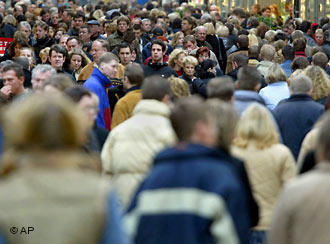7 billion, and counting
There are now more than 7 billion people living on our planet! It’s a reason to celebrate and a stark reminder of how many people live and depend on the planet’s resources. Human population looks like it will continue to grow at breakneck speed, and that means it’s vital we make sure the earth can meet the needs of all 7, 8 or even 9 billion people – when we get to that point.
Climate change poses the biggest threat to meeting the basic food supply needed to nourish the world. Severe weather, changing rain trends and other turnarounds in global climate patterns have put important basic crops at risk – from wheat and corn to coffee. As the supply falls, the prices for food soar, making it too expensive for many in the world’s developing countries.
On top of that, more people means more energy use, and the need for clean, eco-friendly energy on a wide scale will become even more crucial in the coming years. So you’re now one of more than 7 billion people on the planet. What can every person do to keep the world safe?
Energy from…what?
We all know it’s possible to get energy from natural resources like the sun, wind, water, heat, etc. And we know about other interesting sources of energy too, like manure, food scraps, even kitchen grease. But over the years, people have come up with more unusual and just downright odd sources of energy that might surprise you.
Like the company Super Faiths in Japan – they recycle used elderly diapers into – yes, diapers – into fuel for biomass stoves. It may seem strange, but Japan’s population is aging rapidly, and Super Faiths says it’s making use of a ready source of energy. The used diapers are processed in special recycle machines that sterilize, dry and shred the diapers and turn them into fuel pellets.
Another unique source of energy? Confiscated alcohol. A Swedish biogas company called Svensk Biogas AB turns illegal booze into fuel for trucks, buses and trains. And there’s plenty of material to work with: Swedish authorities confiscate hundreds of thousands of liters of alcohol from smugglers every year. Instead of pouring it down the drain, Svensk Biogas AB puts it to good use and helps Sweden reduce its dependency on harmful fossil fuels. Who knew?
Diwali goes green

Diwali is one of the biggest celebrations to take place in India each year. Known as the ”festival of lights,” Diwali usually takes place some time between mid-October and mid-November. During the celebration, families light candles, share gifts and meals, and of course, light fireworks.
Because it’s such a big festival, it’s not unusual to see hazy, smoke-filled air in many towns and cities during Diwali because of all the fire crackers. Unfortunately that’s not so good for the environment. But this year, Diwali is going green with eco-friendly fireworks. They’re made of recycled paper and stuffed with leaves so they emit a lot less smoke and noise. And they’re apparently very popular, too – stores say the special firecrackers are flying off the shelves.
The online portal oneindia.in offers five easy steps on how to prevent pollution during Diwali. It’s not that hard…
Greenpeace has a new vessel
 The new ultra-modern campaign ship of Greenpeace, the Rainbow Warrior III, has made its maiden voyage on Wednesday in Bremerhaven. “It’s a beautiful boat,” said captain Joel Stewart as the ropes were untied to launch the 58-metre (190-foot) long sailing ship. The boats hull is green, with a colourful rainbow and a white dove on the side. The first ride took the Rainbow Warrior III into the River Weser towards the northern German port of Bremerhaven.
The new ultra-modern campaign ship of Greenpeace, the Rainbow Warrior III, has made its maiden voyage on Wednesday in Bremerhaven. “It’s a beautiful boat,” said captain Joel Stewart as the ropes were untied to launch the 58-metre (190-foot) long sailing ship. The boats hull is green, with a colourful rainbow and a white dove on the side. The first ride took the Rainbow Warrior III into the River Weser towards the northern German port of Bremerhaven.
The third boat was build twenty-six years after the original Rainbow Warrior was sunk by French agents in New Zealand. There Greenpeace attempted to stop France’s nuclear testing in the Pacific. The ship was constructed with the help of three million donors, who contributed to the initially estimated 23 million euros (32 million dollars) needed for the construction work. Brigitte Behrens, Greenpeace’s director in Germany said, that this was a very important day. “We are continuing what colleagues began many years ago by using a boat to denounce attacks on the environment,” she added.
The new ship was due in Hamburg Thursday and in Amsterdam — its home port and Greenpeace’s headquarters — on October 28.
After an initial tour in Europe, the 680-tonne ship’s first mission will be to set sail for the American coast before heading along the Amazon in Brazil to campaign against climate change.
The reinvention of two-wheeled driving
California based company Lit Motors, wants to reinvent the motorcycle that we know today. As you can see in the video below, Lit Motors has manufactured a fully enclosed, two-wheeled motorcycle that runs purely on electric. With a top speed of over 120 MPH and battery packs providing 200 miles per charge, the C-1 is already a pretty sexy idea. But the concept-bike can do some more: The engineers also focused very much on safety, it is almost impossible to tip the motorcycle over. A elaborate system of fly wheels takes care of it, says CEO Kim. Well, we would ride a bike like that. It’s still a prototype, but Lit Motors plans to bring the C-1 in custom show-rooms by the end of 2014.










Feedback